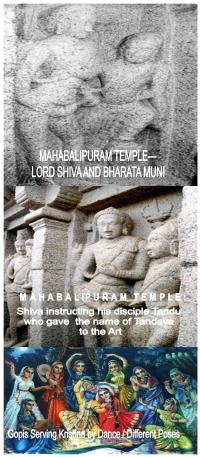Origin of Bharatnatyam


According to Natya Sastra Sangraha, the science of Dramatic presentation was first taught by Brahma to sage Bharatamuni. Sage Bharatamuni then produced before Lord Siva the Three-fold Art of Pure Acting, acting accompanied by dance and pure dance, with the help of his troupe of Gandharvas (Heavenly Musicians) and Apsaras (Heavenly Damsels). Lord Siva was then reminded of his own Dance with energetic movements and had it taught to Bharatmuni by Tandu, the leader of his followers. He also had Lasya (the gentler and more graceful variety of Dance suitable for ladies) taught to Bharatamuni by Parvati who exhibited the Art in his presence.
The Rishis (Bharatamuni and others) having learnt the Art of Tandava (male dance) from Tandu, taught it in their turn to Men; and Sri Parvati Devi taught the Lasya to Usha, the daughter of Bana, who in her turn taught it to the Gopis of Dwaraka; and from the Gopis, the art spread to the ladies of Saurashtra (Kathiawar), Gujarat, and from them to the other parts of the country. In this way the Art of Dance and Drama has been established by tradition. Tandav and Lasya are major parts of Bharatnatyam.
HISTORY OF BHARATNATYAM DANCE IN GUJARAT AND NORTHERN PART OF INDIA
When Sir Sayajirao Gaekwad III came in ruling in Baroda (Vadodara), he married with princess Chimnabai of Tanjore in 1880. Family of Gurushri Kubernath Tanjorkar got opportunity to come to Baroda in 1888.
Prior to birth of Gurushri Kubernath Tanjorkar, his parents did some remarkable work in dance performance. Sir Sayajirao, who did not know Tamil or Telugu, was known to say “I do not need to understand the language as the message of the lyrics is shown through Abhinaya”. Parents of Kubernathji composed and choreographed many compositions for the king, mostly in Hindi, using the mudras and adavus from Bharatanatyam along with other creative movements to enact various scenarios: Some compositions were Radha Krishna dance, Kite flying dance “Laal Patang ” – A kite in flight is nearly thwarted before the two make peace , Scorpion dance, Madhumatta dance, Snake dance etc . All these items were very hit during those days including traditional Bharatnatyam items composed and choreographed by family of Kubernathji.
Gurushri Kubernath Tanjorkar also followed same path and made so many dance items and ballet during his career, in Gujarati, Marathi & Hindi languages, which became popular in Gujarat as well as all over India and abroad.
At present Tanjore Dance Music and Art Research Centre and Tanjore Nrutya Shala, both these institutes are following very strictly the Principles, laid down by Gurushri Kubernathji, under the able guidance of his son-disciple Gurushri Ramesh Tanjorkar and daughter-in-law Gurusmt.Leela Tanjorkar anyd their family and students at present.

